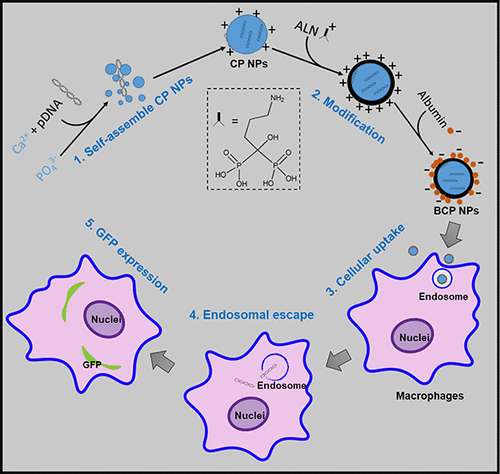当前位置:
X-MOL 学术
›
ACS Appl. Bio Mater.
›
论文详情
Our official English website, www.x-mol.net, welcomes your
feedback! (Note: you will need to create a separate account there.)
Bisphosphonate Stabilized Calcium Phosphate Nanoparticles for Effective Delivery of Plasmid DNA to Macrophages
ACS Applied Bio Materials ( IF 4.6 ) Pub Date : 2020-01-17 , DOI: 10.1021/acsabm.9b00994 Bing Sun 1 , Marianne Gillard 1 , Yanheng Wu 1 , Peihong Wu 2 , Zhi Ping Xu 1 , Wenyi Gu 1
ACS Applied Bio Materials ( IF 4.6 ) Pub Date : 2020-01-17 , DOI: 10.1021/acsabm.9b00994 Bing Sun 1 , Marianne Gillard 1 , Yanheng Wu 1 , Peihong Wu 2 , Zhi Ping Xu 1 , Wenyi Gu 1
Affiliation

|
Calcium phosphate (CP) nanoparticles (NPs) have been used in various applications for delivery of nucleic acid (NA) cargos with ideal biocompatibility and safety. However, some critical issues such as poor stability and aggregation in water solution hinder the industrial application of CP NPs. To further utilize CP NPs for NA delivery, this study specifically focused on the modification of CP NPs to achieve a rapid synthesis and improvement on dispersibility and colloidal stability by using a bisphosphonate (BP) and BSA (named as BCP NPs). Compared with CP NPs, BCP NPs show better stability and dispersity in the cell culture medium, higher efficiency in cellular uptake, and faster dissolution in acidic environments, which are essential requirements for NA vaccine delivery. The cell viability (MTT) assay indicates that BCP NPs have a similar or lower cytotoxicity than free alendronate and Lipofectamine 2000 reagent (L2K) to macrophages (MΦs), a type of typical antigen-presenting cells (APCs). Furthermore, BCP NPs exhibited 85% plasmid DNA (pDNA) loading efficiency and a good endosome escape property. Using a plasmid expressing enhanced green fluorescent protein (pEGFP) as a model system, we showed that BCP NP transfection resulted in a high-level EGFP expression in MΦs, which was even greater than the commercial L2K and electroporation method. This is the first application of a low amount of BP and BSA to modify CP-based NPs with low MΦ cytotoxicity and favorable dispersity, and our data suggest these BCP NPs are an excellent delivery platform for pDNA to MΦs.
中文翻译:

双膦酸盐稳定的磷酸钙纳米颗粒用于将质粒 DNA 有效递送至巨噬细胞
磷酸钙 (CP) 纳米粒子 (NP) 已被用于各种应用中,以提供具有理想生物相容性和安全性的核酸 (NA) 货物。然而,在水溶液中稳定性差和聚集等一些关键问题阻碍了 CP NPs 的工业应用。为了进一步利用 CP NPs 进行 NA 递送,本研究特别关注 CP NPs 的修饰,以通过使用双膦酸盐 (BP) 和 BSA(称为 BCP NPs)实现快速合成和改善分散性和胶体稳定性。与 CP NPs 相比,BCP NPs 在细胞培养基中表现出更好的稳定性和分散性,细胞摄取效率更高,在酸性环境中溶解更快,这是 NA 疫苗递送的基本要求。细胞活力 (MTT) 测定表明,与游离阿仑膦酸盐和 Lipofectamine 2000 试剂 (L2K) 相比,BCP NPs 对巨噬细胞 (MΦs)(一种典型的抗原呈递细胞 (APCs))具有相似或更低的细胞毒性。此外,BCP NPs 表现出 85% 的质粒 DNA (pDNA) 加载效率和良好的内体逃逸特性。使用表达增强型绿色荧光蛋白 (pEGFP) 的质粒作为模型系统,我们发现 BCP NP 转染导致 MΦ 中的高水平 EGFP 表达,这甚至高于商业 L2K 和电穿孔方法。这是首次应用少量 BP 和 BSA 来修饰具有低 MΦ 细胞毒性和良好分散性的基于 CP 的 NPs,我们的数据表明这些 BCP NPs 是 pDNA 到 MΦs 的绝佳传递平台。
更新日期:2020-01-17
中文翻译:

双膦酸盐稳定的磷酸钙纳米颗粒用于将质粒 DNA 有效递送至巨噬细胞
磷酸钙 (CP) 纳米粒子 (NP) 已被用于各种应用中,以提供具有理想生物相容性和安全性的核酸 (NA) 货物。然而,在水溶液中稳定性差和聚集等一些关键问题阻碍了 CP NPs 的工业应用。为了进一步利用 CP NPs 进行 NA 递送,本研究特别关注 CP NPs 的修饰,以通过使用双膦酸盐 (BP) 和 BSA(称为 BCP NPs)实现快速合成和改善分散性和胶体稳定性。与 CP NPs 相比,BCP NPs 在细胞培养基中表现出更好的稳定性和分散性,细胞摄取效率更高,在酸性环境中溶解更快,这是 NA 疫苗递送的基本要求。细胞活力 (MTT) 测定表明,与游离阿仑膦酸盐和 Lipofectamine 2000 试剂 (L2K) 相比,BCP NPs 对巨噬细胞 (MΦs)(一种典型的抗原呈递细胞 (APCs))具有相似或更低的细胞毒性。此外,BCP NPs 表现出 85% 的质粒 DNA (pDNA) 加载效率和良好的内体逃逸特性。使用表达增强型绿色荧光蛋白 (pEGFP) 的质粒作为模型系统,我们发现 BCP NP 转染导致 MΦ 中的高水平 EGFP 表达,这甚至高于商业 L2K 和电穿孔方法。这是首次应用少量 BP 和 BSA 来修饰具有低 MΦ 细胞毒性和良好分散性的基于 CP 的 NPs,我们的数据表明这些 BCP NPs 是 pDNA 到 MΦs 的绝佳传递平台。











































 京公网安备 11010802027423号
京公网安备 11010802027423号